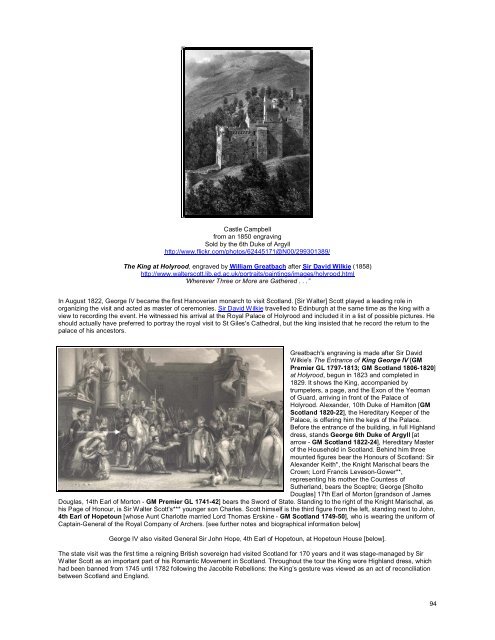Grand Masters of Scotland - Onondaga and Oswego Masonic ...
Grand Masters of Scotland - Onondaga and Oswego Masonic ...
Grand Masters of Scotland - Onondaga and Oswego Masonic ...
You also want an ePaper? Increase the reach of your titles
YUMPU automatically turns print PDFs into web optimized ePapers that Google loves.
Castle Campbell<br />
from an 1850 engraving<br />
Sold by the 6th Duke <strong>of</strong> Argyll<br />
http://www.flickr.com/photos/62445171@N00/299301389/<br />
The King at Holyrood, engraved by William Greatbach after Sir David Wilkie (1858)<br />
http://www.walterscott.lib.ed.ac.uk/portraits/paintings/images/holyrood.html<br />
Wherever Three or More are Gathered . . .<br />
In August 1822, George IV became the first Hanoverian monarch to visit <strong>Scotl<strong>and</strong></strong>. [Sir Walter] Scott played a leading role in<br />
organizing the visit <strong>and</strong> acted as master <strong>of</strong> ceremonies. Sir David Wilkie travelled to Edinburgh at the same time as the king with a<br />
view to recording the event. He witnessed his arrival at the Royal Palace <strong>of</strong> Holyrood <strong>and</strong> included it in a list <strong>of</strong> possible pictures. He<br />
should actually have preferred to portray the royal visit to St Giles's Cathedral, but the king insisted that he record the return to the<br />
palace <strong>of</strong> his ancestors.<br />
Greatbach's engraving is made after Sir David<br />
Wilkie's The Entrance <strong>of</strong> King George IV [GM<br />
Premier GL 1797-1813; GM <strong>Scotl<strong>and</strong></strong> 1806-1820]<br />
at Holyrood, begun in 1823 <strong>and</strong> completed in<br />
1829. It shows the King, accompanied by<br />
trumpeters, a page, <strong>and</strong> the Exon <strong>of</strong> the Yeoman<br />
<strong>of</strong> Guard, arriving in front <strong>of</strong> the Palace <strong>of</strong><br />
Holyrood. Alex<strong>and</strong>er, 10th Duke <strong>of</strong> Hamilton [GM<br />
<strong>Scotl<strong>and</strong></strong> 1820-22], the Hereditary Keeper <strong>of</strong> the<br />
Palace, is <strong>of</strong>fering him the keys <strong>of</strong> the Palace.<br />
Before the entrance <strong>of</strong> the building, in full Highl<strong>and</strong><br />
dress, st<strong>and</strong>s George 6th Duke <strong>of</strong> Argyll [at<br />
arrow - GM <strong>Scotl<strong>and</strong></strong> 1822-24], Hereditary Master<br />
<strong>of</strong> the Household in <strong>Scotl<strong>and</strong></strong>. Behind him three<br />
mounted figures bear the Honours <strong>of</strong> <strong>Scotl<strong>and</strong></strong>: Sir<br />
Alex<strong>and</strong>er Keith*, the Knight Marischal bears the<br />
Crown; Lord Francis Leveson-Gower**,<br />
representing his mother the Countess <strong>of</strong><br />
Sutherl<strong>and</strong>, bears the Sceptre; George [Sholto<br />
Douglas] 17th Earl <strong>of</strong> Morton [gr<strong>and</strong>son <strong>of</strong> James<br />
Douglas, 14th Earl <strong>of</strong> Morton - GM Premier GL 1741-42] bears the Sword <strong>of</strong> State. St<strong>and</strong>ing to the right <strong>of</strong> the Knight Marischal, as<br />
his Page <strong>of</strong> Honour, is Sir Walter Scott's*** younger son Charles. Scott himself is the third figure from the left, st<strong>and</strong>ing next to John,<br />
4th Earl <strong>of</strong> Hopetoun [whose Aunt Charlotte married Lord Thomas Erskine - GM <strong>Scotl<strong>and</strong></strong> 1749-50], who is wearing the uniform <strong>of</strong><br />
Captain-General <strong>of</strong> the Royal Company <strong>of</strong> Archers. [see further notes <strong>and</strong> biographical information below]<br />
George IV also visited General Sir John Hope, 4th Earl <strong>of</strong> Hopetoun, at Hopetoun House [below].<br />
The state visit was the first time a reigning British sovereign had visited <strong>Scotl<strong>and</strong></strong> for 170 years <strong>and</strong> it was stage-managed by Sir<br />
Walter Scott as an important part <strong>of</strong> his Romantic Movement in <strong>Scotl<strong>and</strong></strong>. Throughout the tour the King wore Highl<strong>and</strong> dress, which<br />
had been banned from 1745 until 1782 following the Jacobite Rebellions: the King’s gesture was viewed as an act <strong>of</strong> reconciliation<br />
between <strong>Scotl<strong>and</strong></strong> <strong>and</strong> Engl<strong>and</strong>.<br />
94







![Richard [Nicholls] Harison / Harrison - Onondaga and Oswego ...](https://img.yumpu.com/24950065/1/190x245/richard-nicholls-harison-harrison-onondaga-and-oswego-.jpg?quality=85)

![Richard [Nicholls] Harison / Harrison - Onondaga and Oswego ...](https://img.yumpu.com/24950063/1/190x245/richard-nicholls-harison-harrison-onondaga-and-oswego-.jpg?quality=85)







